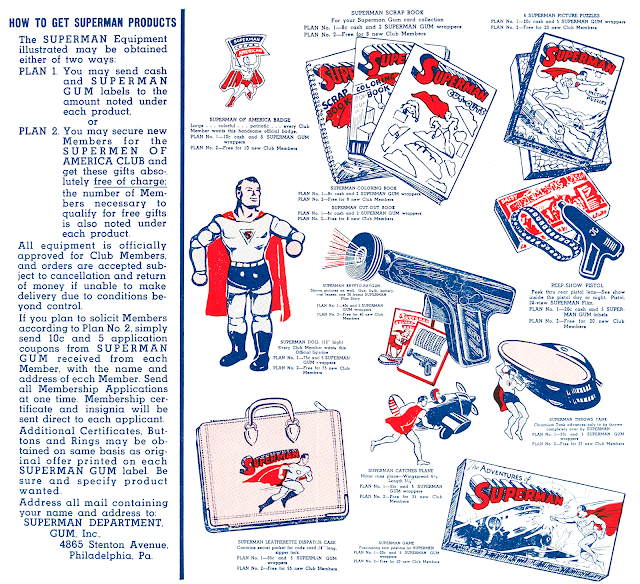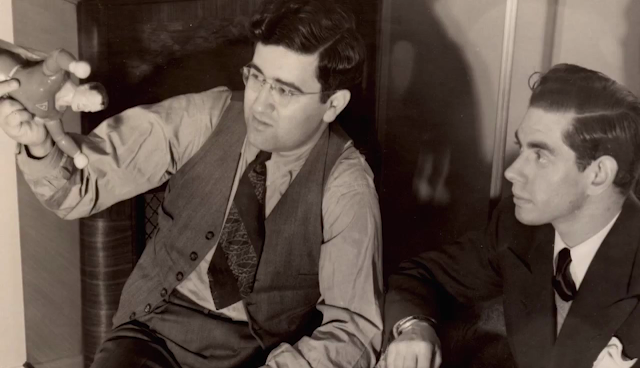Supermen of America Club
The first Supermen of America Club membership application was published in
Superman #1 (Summer 1939). The same announcement appeared two weeks later in
Action Comics #14 (July 1939). For ten cents in coins or stamps,
Charter Members received a welcome letter, membership certificate, pinback
button, and "Superman's Secret Code" card.
"You must promise not to tell anyone the code and you must promise to
strive for strength, courage and justice - just like SUPERMAN does."
The fold-out code card contains nine different cipher keys used to decode
"Superman's Secret Message!" printed in issues of Action Comics and Superman. The first message appeared in Action Comics #15 (August 1939). Unlike the Superman-Tim Club code, "Superman's Secret Code" remained unchanged each year from
1939–1965. A "Kryptonic Code" was included with new membership cards in
1966. The Supermen of America Club was supplanted by the DC Super-Stars
Society in 1977, followed by the DC Superman Club in 1980.
In 1939, members that recruited three friends received a premium Action Comics
emblem patch. The felt emblems measure approximately 5.5 inches in diameter.
The emblem offer appeared in Action Comics #16–18 and
Superman #2. Approximately 20 of the original emblems are estimated to
exist in private collections. A "Leader" variation of the patch was offered as
a premium from Superman Candy & Surprise, manufactured by the Leader Novelty Candy Co. in Brooklyn.
Advertisements in Action Comics #20, #21, and Superman #3
promoted "The greatest contest in comic book history!" From November 1939
until January, 28, 1940, club members could enter to win over 2,000 prizes.
Winners were chosen for the best responses in 100 words of less to "What I
would do if I had the powers of Superman." The winners were announced in
Action Comics #25 (June 1940). Fourth place awarded 100 sweatshirts
with the felt Supermen of America emblem. Sixth place awarded 1,600
adjustable "Supermen of America Member" rings.
The prize rings were also sold for ten cents and five Superman Gum wrappers. The original rings are made of silver-colored brass with
red enamel paint. Approximately two dozen examples of the "Supermen of
America Member" rings are estimated to exist. A rare "Action Comics"
prototype does not include the lightning bolts or planet found on the prize
rings. An illustrated image of the "Action Comics" ring appeared in Action Comics
#20, #21, and Superman #3. There are nine "Action Comics" prototype
rings known to exist.
Superman Gum trading cards were released by
Gum, Inc. in late
1940. Each wax wrapper contains a Supermen of America membership application
certificate. For five wrappers plus the normal ten cent application fee, new
members could chose between the Supermen of America ring or a
cloisonné "Superman American" pinback badge. The badge was also available for free by recruiting ten
new members.
The gum wrappers could be exchanged by mail for premiums that
included the Superman Krypto-Raygun toy from Daisy, a wooden Superman doll
from Ideal, and a caped Superman Playsuit. The first appearance of the word
"kryptonite"
was an advertisement for the Krypto-Raygun in Action Comics #8 (January 1939). Some of the premiums were previously sold at
Macy's Toyland.
On May 20, 1941, President Franklin D. Roosevelt signed Executive Order 8757
Establishing the Office of Civilian Defense (OCD). Supermen of America
advertisements began encouraging readers to buy Savings Bonds and Defense
Stamps in Action Comics #43 (December 1941), on sale October 14,
1941. During
World War II,
membership ads prepared with the Department of War showcased twelve
different "Supermen of the U.S. Army" in Action Comics #49–60.
Regional programs were organized throughout the United States in cooperation
with OCD and the Department of War. The
Superman Junior Defense League of America
was promoted by bread bakeries and radio stations that aired
The Adventures of Superman. Local sponsors of the Superman Victory Kid Club included Boskman Variety, Village Pharmacy and Fountain, and Wigmore Dairy.
Roberts Dairy of Nebraska released the first set of Superman milk bottle
caps for
Roberts Superman Defense Club. Roberts later produced a series of twenty "Code Note" caps encrypted for
Supermen of America members. Milk cap collecting peaked during the early
1990s with the commercialization of the Hawaiian game commonly known as POGs.
Children could join the Supermen of America at select theaters showing the
Superman cartoon reels from Fleischer Studios and Paramount Pictures. In
1941, Superman, Inc. offered 500 free memberships and a 40 x 60 inch poster
to theater operators in return for running a special Supermen Club Trailer. Theaters could separately purchase 500 memberships for $15, or 3 cents
each. The offer was limited to 6,000 setup kits per theater. "Superman's
Secret Code" cards produced for the campaign read "Motion Picture
Membership" on the title panel. Superman, starring Bud Collyer and Joan Alexander, was released on September 26, 1941,
On January 1, 1944, Jerry Siegel asked DC Comics co-founder Jack Liebowitz to mail 131 Supermen of America membership kits to the U.S. Army 39th Special Service Company in Elkins, West Virginia. Jerry and his fellow soldiers wanted to wear the membership buttons as insignia.
During the winters of 1944 and 1945, Supermen of America offered a free
membership kit for joining the March of Dimes against infantile paralysis.
Superman would forward the dimes to President Roosevelt in Washington.
Registered club members received a color postcard illustrated by Wayne
Boring that says "Sincerely, Superman" on the front. A similar campaign
distributed March of Dimes postcards for Wonder Woman, as well as Batman and
Robin. The Superman and Batman postcards were lettered by Ira Schnapp.
A precise membership count for the Supermen of America Club is difficult to
confirm. The February 27, 1940, issue of Look magazine reported that
"fifty-thousand children own certificates." A Paramount advertisement in the
April 30, 1941, issue of The Film Daily states that 170,000 children
paid to join. In the June 21, 1941, issue of The Saturday Evening Post, John Kobler reported the membership level at "some quarter of a
million youngsters." The Campaign Book for Superman released in the fall of 1941 claimed that membership is "rapidly
approaching the million mark." A television syndication campaign in the
February 20, 1961, issue of Sponsor boasted "millions of
paid-up members in the 'Supermen of America' club!"
Different membership materials and premiums were distributed by the Supermen
of Canada and the Superman Club of Great Britain. On July 8, 1947, The Argus
Superman Club was introduced by The Argus, a newspaper in Melbourne,
Australia. For a fee of $2.50 AUD, each member received a certificate, a
Superman badge, and a yearly birthday card. The Argus Superman Club became
the Young Argus Thousand Eyes Club on May 7, 1954.
Club pinback buttons from 1939–1948 depict a Joe Shuster image of Superman breaking chains from the back cover of Superman #1. Due to the legal battle over Superman, Jerry Siegel and Joe Shuster were removed from story bylines after Action Comics #118, Adventure Comics #126 Superman #51, and World's Finest Comics #33. The buttons were changed to a different illustration that was distributed until 1965. Membership certificates, "Secret Code" cards, and welcome letters continued to use the Joe Shuster image until 1966.
The Supermen of America logo from 1939–1961 is based on the cover of
Superman #1 by Joe Shuster and Leo O'Mealia. The telescoping Superman
logo was originally designed by Shuster, first appearing in
Action Comics #1 (June 1938). Shuster and the Cleveland studio would redraw the
Superman logo for each story until Ira Schnapp refined a standard design
around June 1940. According to letterer Todd Klein, Schnapp later updated the logo for Supermen of America
used from 1961 until 1966.
Membership kits mailed from 1961–1966 included a postcard similar to the
cover of Superman #53 (July–August 1948), penciled by Wayne Boring and inked by Stan Kaye. The cards measure 5.375 x 7.375 inches and are
copyrighted 1948 Nat'l Comics Pub., Inc.
An updated Supermen of America Club membership card, oval iron-on patch, and
pinback button were packaged with copies of the
Golden Story Teller Superman record released in 1966. The
membership card contains a "Kryptonic Code" with a new club code. The LP box
set also includes a read-along comic book.
A corroded example of the "Supermen of America Member" ring appeared
in the March 8, 2010, episode of Pawn Stars "Big
Guns." The wooden Superman doll from Ideal appeared in the
episode
"Fender Bender" on October 29, 2015. The prize ring and premium doll are featured as
items in Pawn Stars: The Game released for Android devices in
September 2018 by Fifth Column Games. Rick Harrison, owner of Gold
& Silver Pawn Shop, and the mobile game incorrectly state that the prize
ring is made of steel.
Since 1987, the Smithsonian Institution has archived items from the Supermen
of America Club. A Superman Krypto-Raygun, an Ideal doll, and additional
membership materials are cataloged in the collections of The National Museum
of American History.

.png)








.png)




